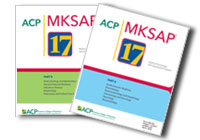 MKSAP has been trusted by internists since 1967 as the best resource for updating knowledge. MKSAP 17, available in Complete, Digital, and Print packages, consists of 11 comprehensive text chapters with related multiple-choice questions. You'll find 1,200 completely new questions to help you identify learning gaps, stay current, and gain the knowledge you need to provide the best possible patient care. MKSAP 17's original and high-quality questions evolve out of case studies and patient scenarios based on the latest evidence.
MKSAP has been trusted by internists since 1967 as the best resource for updating knowledge. MKSAP 17, available in Complete, Digital, and Print packages, consists of 11 comprehensive text chapters with related multiple-choice questions. You'll find 1,200 completely new questions to help you identify learning gaps, stay current, and gain the knowledge you need to provide the best possible patient care. MKSAP 17's original and high-quality questions evolve out of case studies and patient scenarios based on the latest evidence.
For more information on MKSAP 17, or to order your copy, visit mksap17.acponline.org.
MKSAP 17 Q & A
A 78-year-old man is evaluated for gradual hearing loss in the left ear over the past several years. Although hearing in his right ear seems normal, he has noticed that it is more difficult to hear men's voices or lower voices with his left ear. He reports no dizziness, tinnitus, or previous infection or exposure to loud noise in that ear. Medical history is significant for hypertension, hyperlipidemia, and coronary artery disease. Medications are losartan, rosuvastatin, and low-dose aspirin.
On physical examination, the patient is afebrile, blood pressure is 134/82 mm Hg, pulse rate is 85/min, and respiration rate is 13/min. BMI is 29. The tympanic membranes are normal. The remainder of the general medical examination is unremarkable. On neurologic examination, a vibrating tuning fork placed in contact with the patient's forehead at the midline results in vibrations being heard more loudly in the left ear.
Which of the following is the most likely diagnosis?
A: Drug-induced hearing loss
B: Meniere disease
C: Otosclerosis
D: Presbycusis
Click here for the answer and critique.

